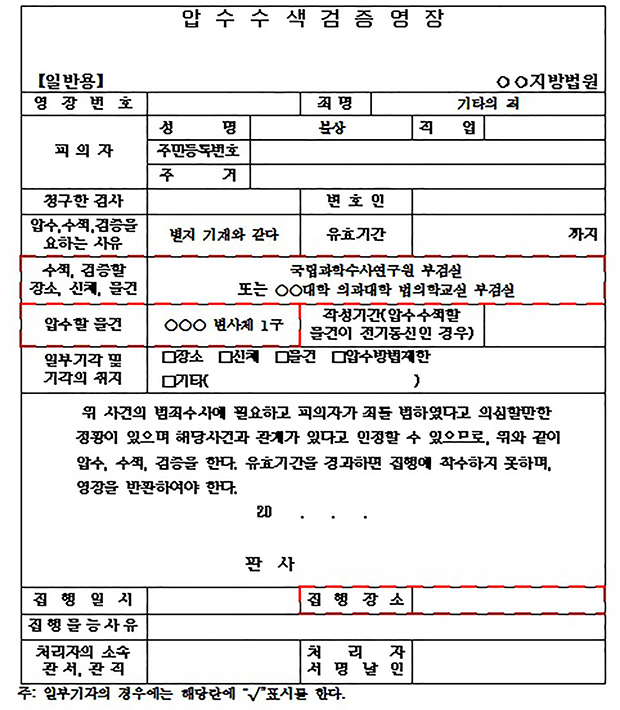Abstract
The death certification system in a modern welfare state is of critical importance because it is related to the collection of national statistics for health policy, social security and social welfare. So, the monitoring of death events by the government has become an important function of a constitutional state. There are two ways in which a death certificate can be issued: the medical judgment by the physician via the death certificate and through a warrant for an autopsy by a law enforcement agency, especially in the case of violent deaths. On a practical level, however, the death certificate issued by a physician may contain serious faults like an inaccurate assessment of the cause of death especially when the death resulted from unnatural causes. The warrant specified in the Constitution and the Criminal Procedure Act also raises the question of whether it is legally fulfilling its original mandate, especially when looking at procedures in the case of suicide or other causes of death that are not related to a crime. The authors, therefore, examined the shortcomings of legal codes related to death certification and warrants for autopsies and propose the reformation of legal codes for the death certification system.
Acknowledgments
This research was supported by Basic Science Research Program through the National Research Foundation of Korea (NRF) funded by the Ministry of Education (No. 2017R1D1A3B03031691).
Appendix
Appendix 1
Form of seizure, search, and verification warrant. In practice, there are some misconceptions about the mentioned items for place, body, object to be searched and verified for warrant, objects to be seized for warrant, and place of execution, which are marked in boxes of red dotted line, respectively.

References
1. World Health Organization. International statistical classification of disease and related health problems. 10th rev. Vol. 2. Geneva: World Health Organization;2004. p. 23–89.
2. Jung WS. Current status and improvement direction of the Korean autopsy system. Korean Soc Law Med. 2006; 7:46–71.
3. Kim YS, Park MI, Park JW, et al. Defect in post-mor tem examination system reviewed by the realities of death certificate issuing. Korean J Leg Med. 2008; 32:101–104.
4. Kim KS, Lim YS, Rhee JE, et al. Problems in completing a death certificate. J Korean Soc Emerg Med. 2000; 11:443–449.
5. Lee SY, Choi YS, Chung NE, et al. Inadequacies of death certification: the role of forensic pathologist. Korean J Leg Med. 2002; 26:72–79.
6. Na JI, Lee YJ, Kim HS, et al. Discrepant causes of death between medical death certificates and autopsy reports (II). Korean J Leg Med. 2012; 36:27–33.

7. Kang YS, Lee KR, Park IC, et al. Survey of the causes of death on the death certificates of DOA patients. J Korean Soc Emerg Med. 2001; 12:385–392.
8. Hanzlick R, Goodin J. Mind your manners. Part III: Individual scenario results and discussion of the National Association of Medical Examiners Manner of Death Questionnaire, 1995. Am J Forensic Med Pathol. 1997; 18:228–245.

9. Bateman AW, Fonagy P. Handbook of mentalizing in mental health practice. Arlington, VA: American Psychiatric Publishing, Inc;2012.
10. Roh JH. Critical research on the current system of seizure and search. Lawyers Assoc J. 2010; 59:5–57.
11. Bateman AW, Fonagy P. Mentalization-based treatment for borderline personality disorder: a practical guide. Oxford: Oxford University Press;2006.
12. Lee SK. Developmental measures to the Korean death examining system: focused on the legal discussion on autopsy. J Leg Stud. 2017; 25:185–207.
13. Kim YS, Kim TE. Review of legal codes governing administrative death investigations and autopsy by administrative order. Korean J Leg Med. 2019; 43:1–6.

14. Kim YS, Kim TE. Review of legislation and regulations governing postmortem inspection and death certification. Korean J Leg Med. 2018; 42:77–91.

15. Kim YS. A review of warrant system for legal autopsy. Korean J Leg Med. 2005; 25:1–7.
16. Jee WR. Civil law. Seoul: Hongmoonsa;2016. p. 151–162.
17. Koo HJ, Lee TY. The primary factors of uncertain cause of death between countries and the statistical influence of postmortem investigation system. Korean Criminol Rev. 2011; 22:173–199.
18. Kim YS, Park JH. An experience of judicial autopsy for a death by muscular dystrophy: an autopsy case. Korean J Leg Med. 2018; 42:159–163.

19. Lee JS. Criminal procedure. Seoul: Bakyoungsa;2012. p. 185–238.
20. Kim HJ, Kim SS, Kim YH. The new police administration. Seoul: Bakyoungsa;2015. p. 13–28.
21. The Korean Society for Legal Medicine. Unnatural death guideline [Internet]. Seoul: The Korean Society for Legal Medicine;2018. cited 2020 Jan 24. Available from: http://www.legalmedicine.or.kr.
22. Rutty GN, Duerden RM, Carter N, et al. Are coroners' necropsies necessary? A prospective study examining whether a “view and grant" system of death certification could be introduced into England and Wales. J Clin Pathol. 2001; 54:279–284.



23. DiMaio VJ, DiMaio D. Forensic pathology. 2nd ed. Florida: CRC Press;2001. p. 3–6.




 PDF
PDF ePub
ePub Citation
Citation Print
Print



 XML Download
XML Download